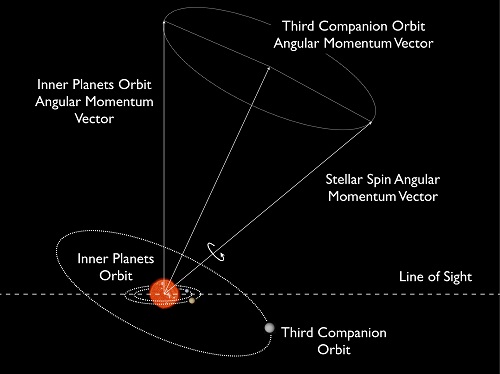The red giant Kepler-56, some 3000 light years from the Sun, is telling us useful things about planetary alignments. The star is somewhat out of synch with the majority of Kepler targets to begin with. Most of these are unevolved stars near the main sequence, which are those most likely to produce systems in which a terrestrial world can be observed. But Kepler-56 has exhausted its hydrogen core and has evolved into a red giant. Two planet candidates have been identified here, orbiting in 10.5 and 21.4 days respectively. In fact, Kepler-56 turns out to be the most evolved star observed by Kepler with more than a single detected planet.
I’m drawing this from the work of Daniel Huber (NASA Ames) who, with a large team of collaborators, has been studying an apparent anomaly in the Kepler-56 system: The rotation axis of the star is tilted about 45 degrees to our line of sight. The Kepler-56 result was a surprise, says Huber, “because we already knew about the existence of two planets transiting in front of Kepler-56. This suggested that the host star must be misaligned with the orbits of both planets. What we found is quite literally a giant misalignment in an exoplanet system.”

Image: The Kepler-56 planetary system features two inner planets orbiting at a severe tilt to their host star — even though there’s no closely orbiting “hot Jupiter” in the system. Credit: Daniel Huber/NASA’s Ames Research Center.
The contrast with our Solar System is apparent: Our planets orbit within 7 degrees of the plane of the Sun’s equator. Kepler-56 is intriguing because we know of giant planets — ‘hot Jupiters’ — whose orbits are likewise out of alignment with the equator of their host stars. One theory suggests that these planets form far out in the planetary system and then migrate because of interactions with the protoplanetary disk to their current position. But the misalignment implies a different and more chaotic scenario, gravitational mishaps through close encounters with other planets in the system.
Kepler-56 seems to support the second interpretation. For the researchers went beyond Kepler data to get ten radial velocity measurements using the HIRES instrument at the Keck 10-meter telescope. What turns up, along with the Doppler signals of the known transiting planets, is what the paper on this work describes as “a slow velocity drift indicating a third, more massive companion in a wide orbit.” Analyses of the orbits of the transiting planets shows they are nearly circular and co-planar as well as being misaligned with the host star’s equatorial plane.
What to make of this? From the paper:
The radial velocity drift implies a third companion with the mass of a gas-giant planet within a few astronomical units, or a brown dwarf or star within several dozen astronomical units. In either case, if the third companion’s orbit is itself inclined with respect to the inner planetary orbits (for example through planet-planet scattering, if the companion is a planet), it could have torqued the orbits of the inner planets out of the equatorial plane of the host star. The inner planetary orbits would stay aligned with one another because of strong coupling between their orbits, resulting in a misalignment of the two co-planar transiting planets with the host star. Dynamical simulations that include a third companion in an eccentric orbit inclined to the equatorial plane of the host star confirm that such a mechanism can reproduce the architecture of the Kepler-56 system.
We learn from Kepler-56 that ’tilted’ planetary orbits happen in systems without hot Jupiters, with torques induced by wide-orbiting companions a possible cause. What’s ahead for this particular system is further observation to determine whether the third companion of this star is itself a planet or a star. The paper argues that if the third object is a planet, this would imply that the original misalignment happened after the planets had formed. If it is a star, the misalignment would have occurred before planets formed in the primordial protoplanetary disk.
A final issue: Is the equator of a star a reliable marker for the initial orbital plane of the protoplanetary disk in the first place? At least two recent papers have called this into question. “Important test cases,” the Huber paper concludes, “are co-planar multi-planet systems which, if primordial alignments are common, should predominantly show low obliquities. Indeed, until now all transiting multi-planet systems have been found to be well-aligned.”
The paper is Huber et al., “Stellar Spin-Orbit Misalignment in a Multiplanet System,” Science Vol. 342, No. 6156 (18 October 2013), pp. 331-334 (abstract). See also this NASA Ames news release.



Certainly an interesting one – it is a shame that the main discovery methods are either fairly insensitive to or biased against finding “3D” planetary systems.
In other Kepler news, a seventh transiting planet has been independently detected in the “compact solar system analogue” KOI-351 by Planet Hunters and another team. Bizarre planetary systems seem to be the new normal.
(accidentally got second link wrong – this is the correct one)
What’s even more strange than the planetary alignment is the nature of the star itself! A red giant with a diameter of four suns is wierd enough, but an optical luminosity of ONLY NINE SUNS is off the charts! For example:Pollux has a radius of about 6 suns, and a luminosity of about 30 suns(sombody help me out here)! A highly unlikely, but not impossible implication of this is an extraterrestrial “STARIVORE” civilization collecting most of the light, and thus REDUCING the diameter of the star,somehow!
Harry R Ray: how do you imagine a star gets from the main sequence to a state with 30 solar luminosities?
You might want to take a look at figure S9 in the paper which shows the relevant stellar evolutionary tracks.
Nothing strange going on with the stellar properties at all, really.